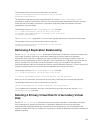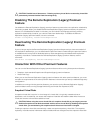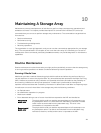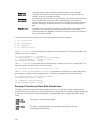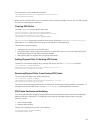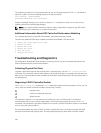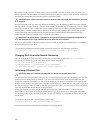
Type of Information Description
module pair, regardless if one, both, or neither
are selected for monitoring
Total I/Os Number of total I/Os performed since the storage array was started
Read Percentage Percentage of total I/Os that are read operations (calculate the write
percentage by subtracting the read percentage from 100 percent)
Cache Hit Percentage Percentage of reads that are fulfilled by data from the cache rather
than requiring an actual read from a physical disk
Current KB/second Current transfer rate in kilobytes per second (current means the
number of kilobytes per second since the last time the polling interval
elapsed, causing an update to occur)
Maximum KB/second Highest data transfer value achieved in the current kilobyte-per-
second statistic block
Current IO/second Current number of I/Os per second (current means the number of
I/Os per second since the last time the polling interval elapsed,
causing an update to occur)
Maximum IO/second Highest number of I/Os achieved in the current I/O-per-second
statistic block
The general form of the command is:
save storageArray performanceStats file="filename"
where, file is the name of the file in which you want to save the performance statistics. You can use any
file name your operating system can support. The default file type is
.csv. The performance information is
saved as a comma-delimited file.
Before using the save storageArray performanceStats command, run the set session
performanceMonitorInterval and set session performanceMonitorIterations commands
to specify how often statistics are collected.
Changing RAID Levels
When creating a disk group, define the RAID level for the virtual disks in that group. You can later change
the RAID level to improve performance or provide more secure protection for your data. To change the
RAID level, run the following command:
set diskGroup [diskGroupNumber] raidLevel=(0|1|5|6)
where, diskGroupNumber is the number of the disk group for which to change the RAID level.
Changing Segment Size
When creating a new virtual disk, define the segment size for that virtual disk. You can later change the
segment size to optimize performance. In a multi-user database or file system storage environment, set
your segment size to minimize the number of physical disks needed to satisfy an I/O request. Use larger
values for the segment size. Using a single physical disk for a single request leaves other disks available to
simultaneously service other requests. If the virtual disk is in a single-user large I/O environment,
115



